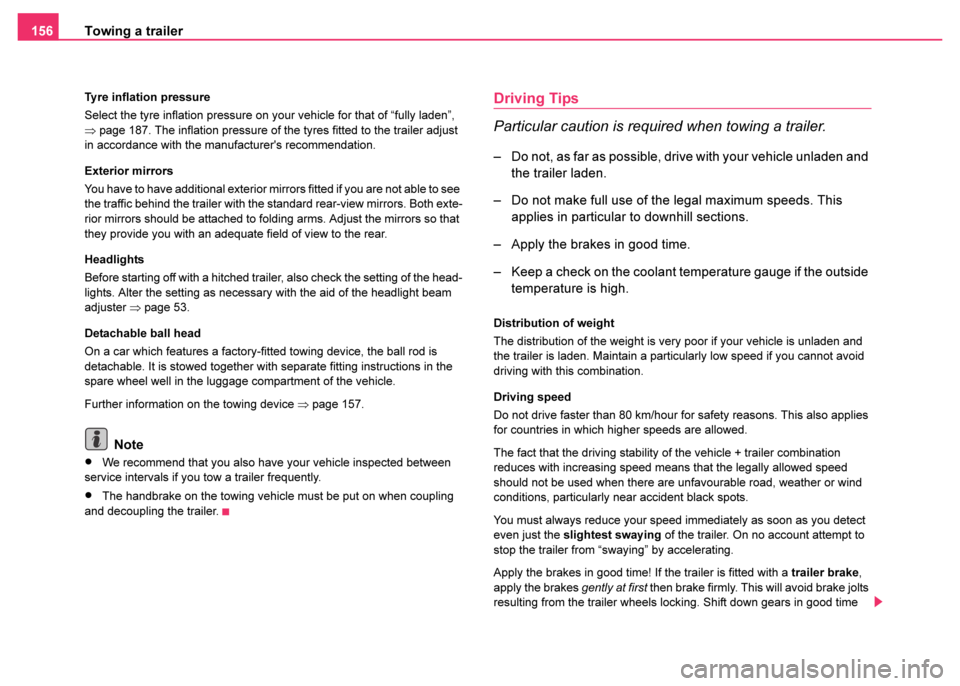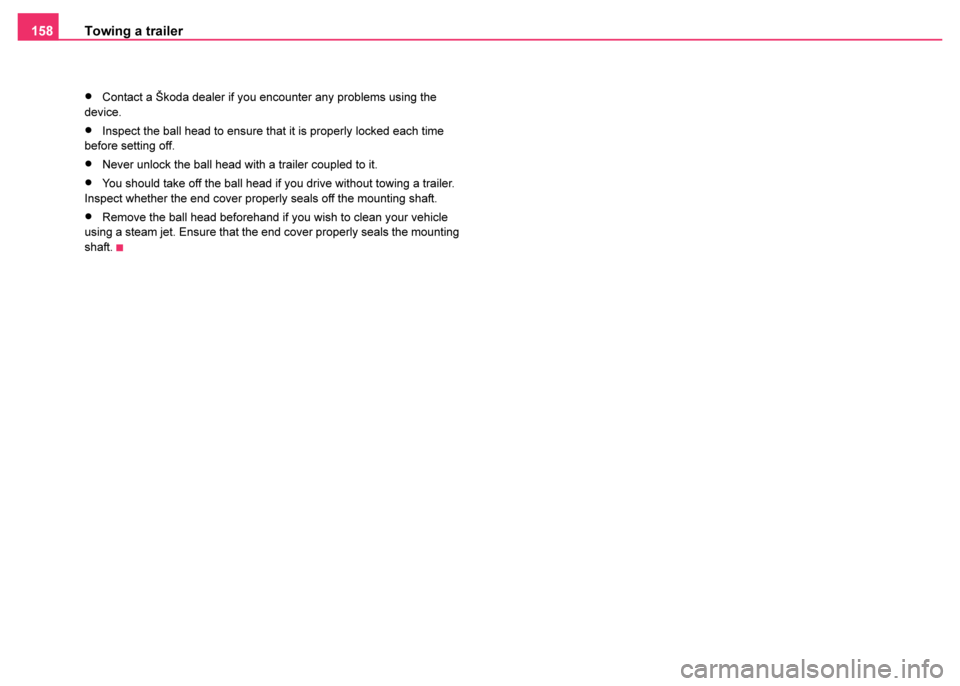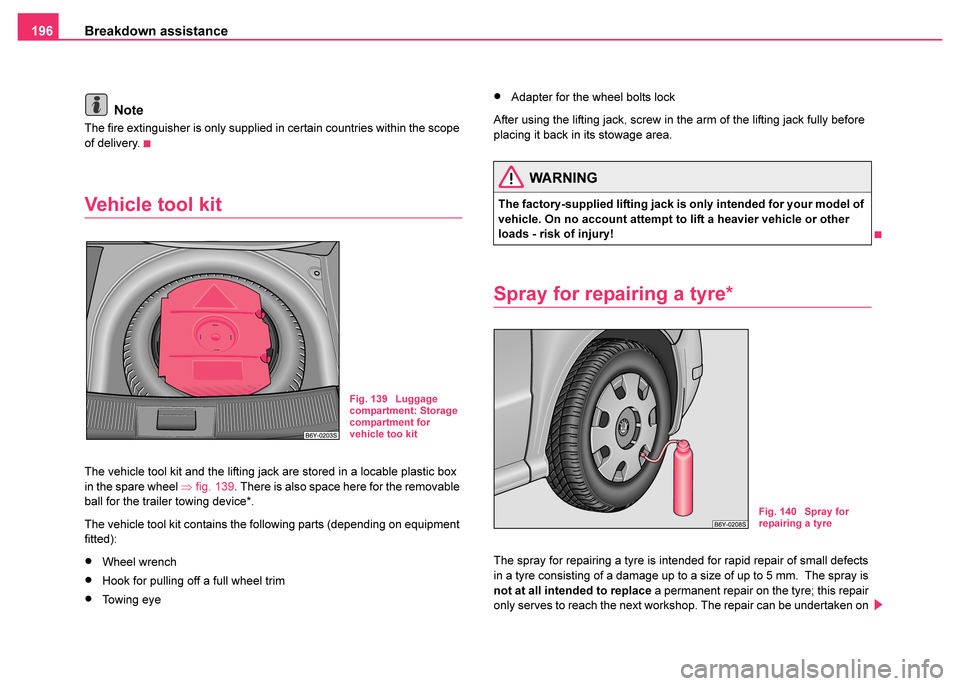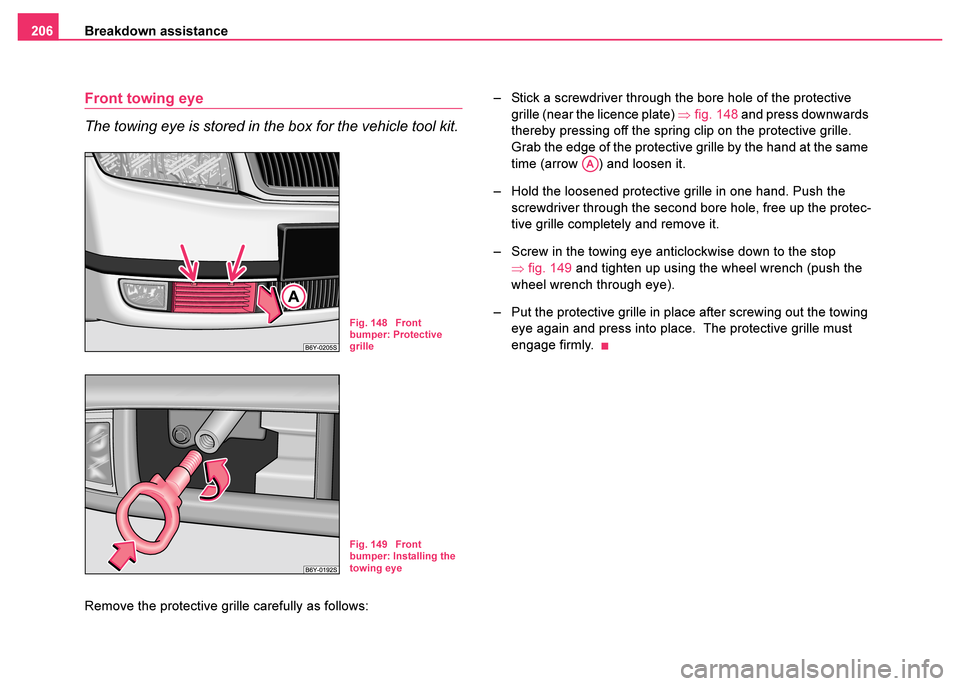2003 SKODA FABIA towing
[x] Cancel search: towingPage 157 of 233

Towing a trailer
156
Tyre inflation pressure
Select the tyre inflation pressure on your vehicle for that of “fully laden”,
⇒ page 187. The inflation pressure of the tyres fitted to the trailer adjust
in accordance with the manufacturer's recommendation.
Exterior mirrors
You have to have additional exterior mirrors fitted if you are not able to see
the traffic behind the trailer with the standard rear-view mirrors. Both exte-
rior mirrors should be attached to folding arms. Adjust the mirrors so that
they provide you with an adequate field of view to the rear.
Headlights
Before starting off with a hitched trailer, also check the setting of the head-
lights. Alter the setting as necessary with the aid of the headlight beam
adjuster ⇒page 53.
Detachable ball head
On a car which features a factory-fitted towing device, the ball rod is
detachable. It is stowed together with separate fitting instructions in the
spare wheel well in the luggage compartment of the vehicle.
Further information on the towing device ⇒page 157.
Note
•We recommend that you also have your vehicle inspected between
service intervals if you tow a trailer frequently.
•The handbrake on the towing vehicle must be put on when coupling
and decoupling the trailer.
Driving Tips
Particular caution is required when towing a trailer.
– Do not, as far as possible, drive with your vehicle unladen and the trailer laden.
– Do not make full use of the legal maximum speeds. This applies in particular to downhill sections.
– Apply the brakes in good time.
– Keep a check on the coolant temperature gauge if the outside temperature is high.
Distribution of weight
The distribution of the weight is very poor if your vehicle is unladen and
the trailer is laden. Maintain a particularly low speed if you cannot avoid
driving with this combination.
Driving speed
Do not drive faster than 80 km/hour for safety reasons. This also applies
for countries in which higher speeds are allowed.
The fact that the driving stability of the vehicle + trailer combination
reduces with increasing speed means that the legally allowed speed
should not be used when there are unfavourable road, weather or wind
conditions, particularly near accident black spots.
You must always reduce your speed immediately as soon as you detect
even just the slightest swaying of the trailer. On no account attempt to
stop the trailer from “swaying” by accelerating.
Apply the brakes in good time! If the trailer is fitted with a trailer brake,
apply the brakes gently at first then brake firmly. This will avoid brake jolts
resulting from the trailer wheels locking. Shift down gears in good time
Page 158 of 233

Towing a trailer157
Using the systemSafetyDriving TipsGeneral MaintenanceBreakdown assist-
anceTechnical DataFabia Praktik
before negotiating a downhill section to allow the engine to also act as a
brake.
Engine overheating
Please keep a check on the coolant temperature gauge if you have to
negotiate a lengthy downhill stretch in a low gear at a high engine speed
when the outside temperature is very high
⇒page 13. If the needle of the
coolant temperature gauge moves into the right-hand area or even the red
area of the scale, reduce your speed immediately. Stop and switch off the
engine if the warning light
in the instrument cluster begins flashing.
Wait a few minutes and check the level of coolant in the coolant expansion
bottle ⇒page 177.
Please refer to the notes ⇒page 31.
The coolant temperature can be reduced by switching on the heating.
Any increase in the cooling effect of the coolant fan through shifting down
a gear and increasing the engine speed is not possible since the fan
speed is independent of the engine speed. One should also not drop a
gear for this reason when towing a trailer as long as the engine can
manage the slope without any drop in speed.
Detachable towing device*
The detachable ball head of the towing device is stowed in the spare
wheel well in the luggage compartment.
An instruction for correct installation and removal of the ball head of the
towing device is supplied with the ball head
Note
•Do not carry out any modifications or repairs to the ball head or to any
other components on the towing device.
WARNING
Do not use any aids or tools for installing or removing the ball
head. This might result in damage to the locking mechanism to the
extent that the safety of the towing device is no longer assured -
risk of an accident.
Fig. 120 Detachable
ball head
Page 159 of 233

Towing a trailer
158
•Contact a Škoda dealer if you encounter any problems using the
device.
•Inspect the ball head to ensure that it is properly locked each time
before setting off.
•Never unlock the ball head with a trailer coupled to it.
•You should take off the ball head if you drive without towing a trailer.
Inspect whether the end cover properly seals off the mounting shaft.
•Remove the ball head beforehand if you wish to clean your vehicle
using a steam jet. Ensure that the end cover properly seals the mounting
shaft.
Page 177 of 233

Inspecting and Replenishing
176
We recommend maintaining the oil level within the range if the engine
has been operating at high loads, for example during a lengthy motorway
trip during the summer months, towing a trailer or negotiating a high
mountain pass, but not above this .
The warning light in the instrument cluster* will indicate ⇒page 32
whether the oil level is too low. In this case, check the oil level as soon as
possible. Top up with an appropriate quantity of oil.
For clarity, the figure shows only part of the engine compartment with a
1.4 litre/74 kW engine ⇒page 175, fig. 127 and a 1.2 litre/40 kW engine
⇒ page 175, fig. 128.
Caution
The oil level must on no account go beyond the range . Danger of
damaging the catalytic converter.
Replenishing engine oil
– Unscrew the cap of the engine oil filler opening
⇒page 175, fig. 128 .
– Pour in a suitable grade of oil in portions of 0.5 litres ⇒page 174, “Engine oil specifications”.
– Inspect the oil level ⇒page 175.
– Carefully screw on the cap of the filler opening and push the dipstick in fully.
Do not continue your journey if for some reason it is not possible under
the conditions prevailing to top up with oil. Switch of the engine and
obtain professional assistance from a Škoda dealer.
For the sake of the environment
The oil level must on no account go beyond the range ⇒page 175. Oil
will otherwise be drawn in through the crankcase ventilation and may pass
through the exhaust system to atmosphere. The oil may combust in the
catalytic converter and damage it.
Changing oil
The engine oil must be changed at the intervals stated in the Service
Schedule or according to the service interval indicator ⇒page 15.
For the sake of the environment
•You must on no account pour oil into the ground or into the sewage
system.
•In view of the problems involved in properly disposing of old oil, the
material, equipment and the knowledge required for such work, we recom-
mend that you have the oil and oil filter change carried out by your Škoda
dealer.
Ac
Ac
AB
WARNING
Avoid dripping oil onto hot parts of the engine when topping up will
oil - a risk of fire!
WARNING
Store old oil in a safe place out of the reach of children until you
can dispose of it properly.
Ac
Page 197 of 233

Breakdown assistance
196
Note
The fire extinguisher is only supplied in certain countries within the scope
of delivery.
Vehicle tool kit
The vehicle tool kit and the lifting jack are stored in a locable plastic box
in the spare wheel ⇒ fig. 139. There is also space here for the removable
ball for the trailer towing device*.
The vehicle tool kit contains the following parts (depending on equipment
fitted):
•Wheel wrench
•Hook for pulling off a full wheel trim
•To w i n g e y e
•Adapter for the wheel bolts lock
After using the lifting jack, screw in the arm of the lifting jack fully before
placing it back in its stowage area.
Spray for repairing a tyre*
The spray for repairing a tyre is intended for rapid repair of small defects
in a tyre consisting of a damage up to a size of up to 5 mm. The spray is
not at all intended to replace a permanent repair on the tyre; this repair
only serves to reach the next workshop. The repair can be undertaken on
Fig. 139 Luggage
compartment: Storage
compartment for
vehicle too kit
WARNING
The factory-supplied lifting jack is only intended for your model of
vehicle. On no account attempt to lift a heavier vehicle or other
loads - risk of injury!
Fig. 140 Spray for
repairing a tyre
Page 206 of 233

Breakdown assistance205
Using the systemSafetyDriving TipsGeneral MaintenanceBreakdown assist-
anceTechnical DataFabia Praktik
Tow-starting and towing vehicle
General
Please pay attention to the following instructions if you are going
to use a tow rope:
Driver of the towing vehicle
– Do not drive off until the tow rope is taught.
– Release the clutch particularly gently when starting off or
depress the accelerator particularly gently if your vehicle is
fitted with an automatic gearbox.
Driver of the towed vehicle
– Switch the ignition on so that the steering wheel is not blocked and you can also operate the turn signal lights, the headlight
flasher, the windscreen wipers and windscreen washer
system.
– Take the vehicle out of gear or move the selector lever into position N if your vehicle is fitted with an automatic gearbox.
– Note that the brake servo unit and power steering only operate if the engine is running. You will require significantly greater
physical force to depress the brake pedal and to steer the
vehicle if the engine is not running.
– Ensure that the tow rope is always kept taught.
Tow rope or tow bar
A tow bar is safest way of towing a vehicle and also minimizes any
shocks. You can use a tow rope only if a suitable tow bar is not available.
The tow rope must be elastic to protect the vehicle. Thus one should only
use plastic fibre rope or a rope made out of a similarly elastic material.
Only attach the tow rope to the towing eyes provided for this purpose
⇒ page 206, “Front towing eye” and ⇒page 207, “Rear towing eye”.
Driving style
Towing another vehicle requires a certain amount of practice. Both drivers
should be familiar with the particular points about towing a vehicle.
Unskilled drivers should not attempt to tow-start or tow in another vehicle.
One should be constantly vigilant not to allow impermissibly high towing
forces or jerky loadings. There is always a risk of excessive stresses and
damage resulting at the points to which you attach the tow rope or tow bar
when you attempt to tow a vehicle which is not standing on a paved road.
Caution
If the gearbox of your vehicle no longer contains any oil because of a
defect, your vehicle must only be towed in with the driven wheels raised
clear of the ground, or on a special vehicle transporter or trailer.
Note
•Please comply with any legal requirements particularly regarding the
switched on signal systems, when towing in or tow-starting another
vehicle.
•The tow rope must not be twisted as it may in certain circumstances
result in the front towing eye being unscrewed out of your vehicle.
Page 207 of 233

Breakdown assistance
206
Front towing eye
The towing eye is stored in the box for the vehicle tool kit.
Remove the protective grille carefully as follows: – Stick a screwdriver through the bore hole of the protective
grille (near the licence plate) ⇒fig. 148 and press downwards
thereby pressing off the spring clip on the protective grille.
Grab the edge of the protective grille by the hand at the same
time (arrow ) and loosen it.
– Hold the loosened protective grille in one hand. Push the screwdriver through the second bore hole, free up the protec-
tive grille completely and remove it.
– Screw in the towing eye anticlockwise down to the stop ⇒fig. 149 and tighten up using the wheel wrench (push the
wheel wrench through eye).
– Put the protective grille in place after screwing out the towing eye again and press into place. The protective grille must
engage firmly.
Fig. 148 Front
bumper: Protective
grille
Fig. 149 Front
bumper: Installing the
towing eye
AA
Page 208 of 233

Breakdown assistance207
Using the systemSafetyDriving TipsGeneral MaintenanceBreakdown assist-
anceTechnical DataFabia Praktik
Rear towing eye
The rear towing eye is located below the rear bumper on the right
⇒fig. 150 .
Tow-starting a vehicle
The following points should be observed by the driver of the
vehicle vehicle being towed before tow-starting begins:
– Engage 2nd or 3rd gear with the vehicle stationary.
– Depress the clutch pedal fully and keep it depressed.
– Switch on the ignition.
– Wait until both vehicles are moving then release the clutch
pedal slowly. – Depress the clutch pedal fully when the engine fires and take
the vehicle out of gear.
First make an attempt to start the engine using the battery of another
vehicle if the engine does not start ⇒page 203. You can try tow-starting
the vehicle if this attempt to start the engine does not prove successful.
Towing your vehicle causes the engine to start through the motion of the
driven wheels.
Models fitted with an automatic gearbox must not be tow-started at all for
technical reasons
Caution
•Vehicles which are fitted with a catalytic converter should not be tow-
started over a distance of more than 50 metres. Unburnt fuel may get into
the catalytic converter and damage it.
•Tow-starting a vehicle is not recommended (even when observing the
guidelines outlined in this chapter) since it may, under certain circum-
stances, lead to major damage to the engine. One should attempt to start
the engine using jump start cables or call on the services of the SERVICE
mobile.
Towing in a vehicle fitted with a manual gearbox
Please refer to the notes ⇒page 205.
Fig. 150 Rear towing
eye
WARNING
There is high risk of having an accident when tow-starting a
vehicle, when for example the towed vehicle runs into the towing
vehicle.